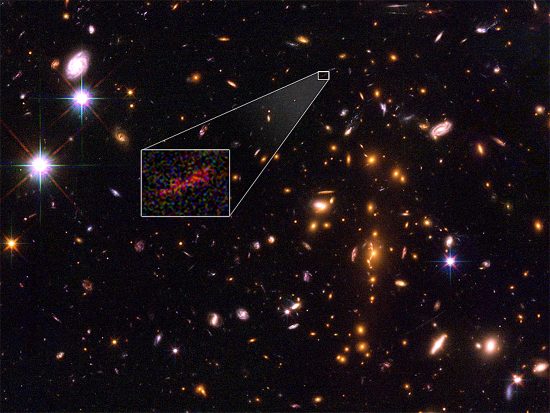
Astronomers think that SPT0615-JD is the most distant object from Earth. Credit: NASA, ESA, and B. Salmon (STScI).
Jun 15, 2018
The most distant object in the Universe?
Astronomers announced that the Hubble Space Telescope and the twin, 10-meter Keck telescopes, detected an object 13.1 billion light-years from Earth, making it the most distant object ever detected.
Virtually every astronomer bases his or her understanding of the Universe on the Big Bang theory. Once, there was no matter, no space, and no time. For some unexplained reason, an irruption of energy from another version of existence, a “primordial egg”, replaced that emptiness with matter and energy, which began to expand and then “inflate”.
The Big Bang theory was developed because Edwin Hubble believed that he observed distant galaxies receding from the Milky Way. He was shocked, but not by the recession, itself, but by the high velocities associated with them. He measured some galaxies flying away at thousands of kilometers per second.
Adapting Christian Doppler’s discoveries about spectroscopy, Hubble thought that the change in location of particular elemental signatures called Fraunhofer lines (for the German physicist Joseph von Fraunhofer), indicated that the light had been “redshifted” by an apparent recessional velocity.
Black Fraunhofer lines exist at specific frequencies in the spectrum, because different elements absorb different colors. If the lines appear in different locations, they have been Doppler-shifted because of the element’s acceleration, either towards the observer (blueshifted) or away (redshifted). That is the basis for distance calculations and the supposed speed of recession. Using that system, some galaxies are thought to be moving away from Earth at 90% of light-speed. A galaxy 13 billion light-years away is also seen as it was 13 billion years ago. Astronomers believe that they are seeing ancient light that traveled through space for 13 billion years.
Hubble’s galactic distances versus recession led to another quandary: galaxies that are far enough away would move so fast that they would exceed the speed of light. This is known as the Hubble radius. It is the point where observations can never be made, because light can never catch up to the observer.
How did these twists and turns in ideas, as well as the warping of time and space come about? They are the direct result of the assumption that redshift correlates with distance. Modern cosmological systems are all built, without exception, on that assumption. What if Hubble’s original premise was flawed? What if redshift is really a red herring?
The late, Halton Arp speculated that redshift is composed not of a velocity value alone, but also depends on what he called “intrinsic redshift.” Intrinsic redshift is a property of matter, like mass or charge, and can change over time. According to his theory, when a quasar is ejected from a parent galaxy it possess a high intrinsic redshift, z = 2 or greater.
As it moves away from its origin, its redshift property begins to decrease until it reaches close to z = 0.3. At that point, it will resemble a galaxy, albeit a small one. The inertial moment of ejection is eventually overcome and quasar mass increases, while the speed of ejection decreases, until it may become a companion galaxy. It is in that way that galaxies form and age, evolving from highly redshifted quasars, to small irregular galaxies, and then into larger barred spirals.
There is nothing conclusive in mainstream scientific journals about Arp’s data. His telescope time in the United States was cut off many years ago by decision-makers who allot that time to various research groups. His revelations concerning problems with consensus dogma were considered intolerable, so he was summarily censured by his peers. However, the evidence he gathered ought to make us stop and think: is the Big Bang dead? How big and how old is the Universe if redshift readings are not reliable indicators of distance? Just how “far away” is SPT0615-JD?
Stephen Smith
All topics described in the Picture of the Day are searchable using Google, Bing or Yahoo with the following syntax, site:thunderbolts.info search term. For example, site:thunderbolts.info plasma will return all posts that mention “plasma”.












